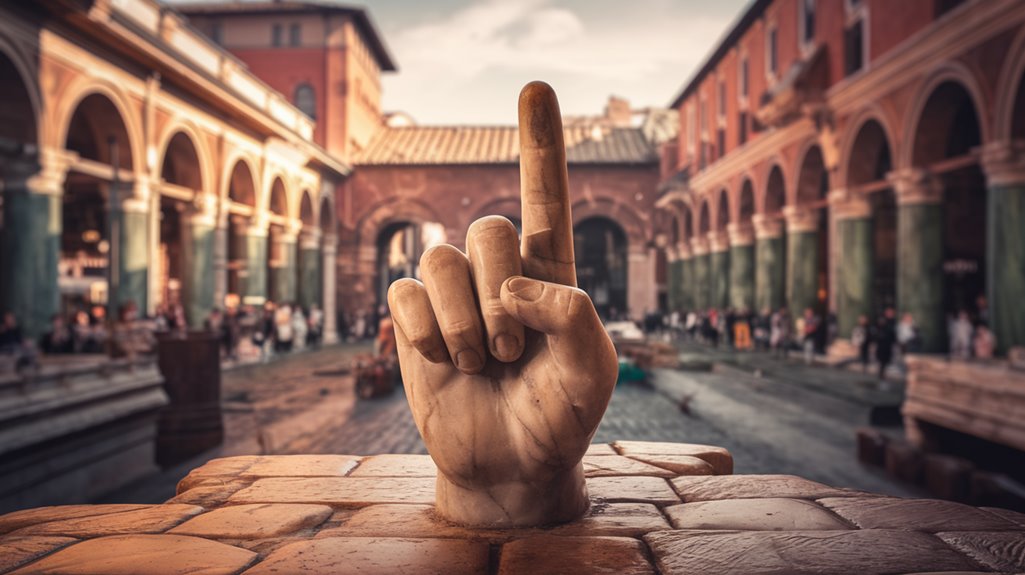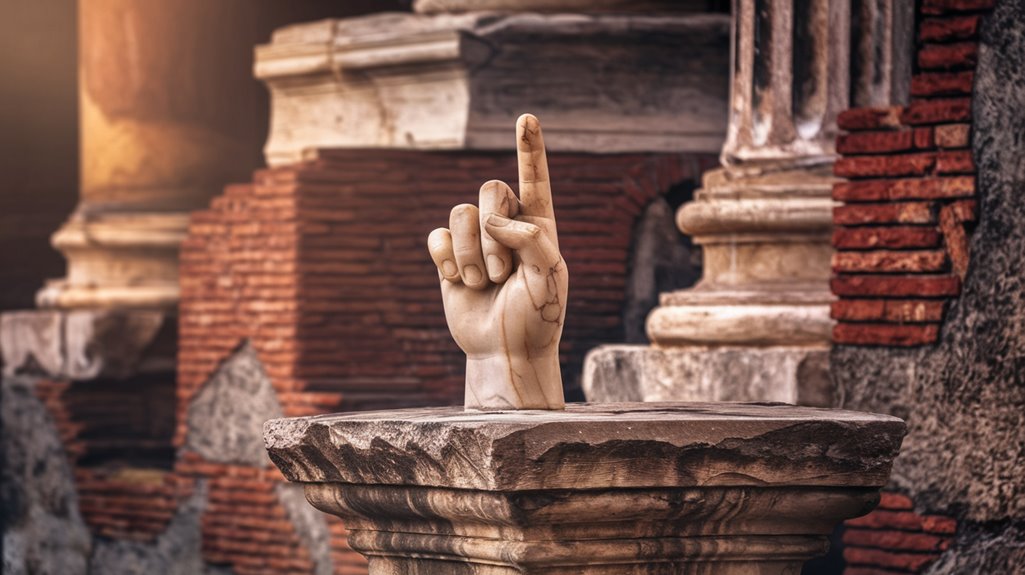That Rude Finger: Ancient Rome’s Influence on Today’s Gesture
You've likely flashed or received the infamous middle finger at some point, but you might not realize you're participating in a gesture that's over two thousand years old. When you raise that particular digit in frustration, you're channeling the same emotional display that ancient Romans called "digitus impudicus" – the shameless finger. What began as a specific Roman insult has transformed into one of the world's most recognized nonverbal expressions of contempt.
The Ancient Origins of the Middle Finger

While many modern gestures have relatively recent origins, the middle finger's history stretches back to ancient Greece, where it first appeared in written records around 419 BC.
The ancient symbolism began in a Greek play called "The Clouds," where the gesture represented male genitalia, with the extended finger symbolizing the penis and curled fingers representing testicles.
You'll find this gesture's cultural significance grew stronger when the Romans adopted it, calling it "digitus impudicus" or the indecent finger.
Emperor Caligula demonstrated its power as a tool of humiliation by forcing his subjects to kiss his middle finger.
Even Greek philosophers employed this gesture, as evidenced by a notable incident in 330 BC when one used it to express contempt toward a politician.
The Romans initially viewed the middle finger as protective symbol against evil spirits and misfortune.
The gesture's prominence diminished during the Middle Ages, when it was initially seen as a joking gesture rather than a serious insult.
Roman Gestures and Their Cultural Context
The middle finger wasn't the only provocative gesture in ancient Rome – gestures formed a rich tapestry of nonverbal communication throughout Roman society.
You'd find that gesture symbolism played a significant role in daily life, from political meetings to social gatherings.
When you examine Roman cultural nuances, you'll discover that seemingly simple actions carried deep meaning. The joining of right hands (dextrarum iunctio) symbolized trust and agreement, while extending the arm had specific rules – like never raising your hand above eye level during speeches.
Even thumb gestures held opposite meanings in different contexts, particularly in gladiatorial contests where they could signal life or death. Romans considered pointing horizontally with the middle finger an insult, demonstrating how specific finger positions conveyed distinct social messages.
These gestures weren't random; they reflected a sophisticated system of nonverbal communication that Romans used to navigate their complex social hierarchy. Historical evidence shows that the modern Roman salute was not actually practiced in ancient Rome, contrary to popular belief.
The Evolution of Hand Signs Through History
During the Middle Ages, you'd see monasteries developing their own sign languages, while ancient Romans used the middle finger as protection against evil spirits – quite different from today's insulting meaning. Plains Indian tribes used hand signs extensively as a universal language for trade between different language groups.
The gesture's transformation from spiritual symbol to universal insult showcases how hand signs adapt across cultures and time. Much like the Bellamy salute, which underwent a dramatic shift from being part of the American Pledge to being permanently abandoned after World War II, gestures can completely change meaning based on historical events.
What began as prehistoric humans' primary communication method has become a sophisticated system of expression that transcends language barriers.
Modern Misconceptions About Classical Gestures
Popular entertainment has deeply misled us about ancient Roman gestures, particularly the famous thumbs-up and thumbs-down signals.
These thumb gesture misconceptions stem largely from Gérôme's 1873 painting "Pollice Verso" and Hollywood's subsequent interpretation of gladiator signaling.
You'll be surprised to learn that:
- The thumbs-up gesture actually meant death in ancient Rome, not approval as we use it today.
- To spare a gladiator's life, spectators would hide their thumb in their fist.
- The Latin phrase "pollice verso" simply means "turned thumb" without specifying direction.
- There's no historical evidence that Romans used the middle finger as an insult like we do today.
Modern media has created an entirely false narrative about these ancient gestures, and you're likely carrying these misconceptions without realizing it. While spectators did influence outcomes, the final decision maker was actually the editor of the games. The gesture of hiding the thumb in a fist was known as pollice compresso, symbolizing a sheathed sword.
The Global Journey of Offensive Hand Signals

From ancient Rome's "digitus impudicus" to today's universal middle finger, offensive hand signals have evolved into a complex global language of insults.
You'll find that gesture interpretation varies considerably across cultures, with what's offensive in one region being harmless in another. For instance, while you might casually point with your index finger in America, you'd want to avoid this in many Middle Eastern countries. The open-handed bent finger remains a distinctly Greek alternative for expressing extreme displeasure.
The cultural significance of these gestures extends beyond mere rudeness. What started as ancient Rome's phallic reference has transformed through centuries of cultural exchange. The modern interpretation of thumbs-up became widely adopted after pilot pre-flight checks.
You'll notice that even common gestures like the thumbs-up, which once meant death in Roman times, now carry entirely different meanings. As you travel globally, you'll discover that understanding these cultural nuances isn't just polite—it's essential for avoiding unintended offense.










